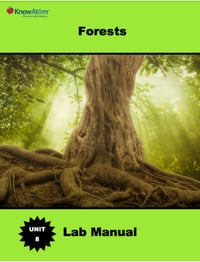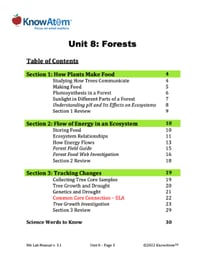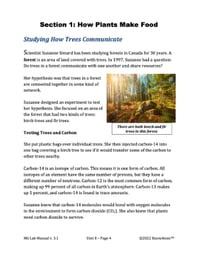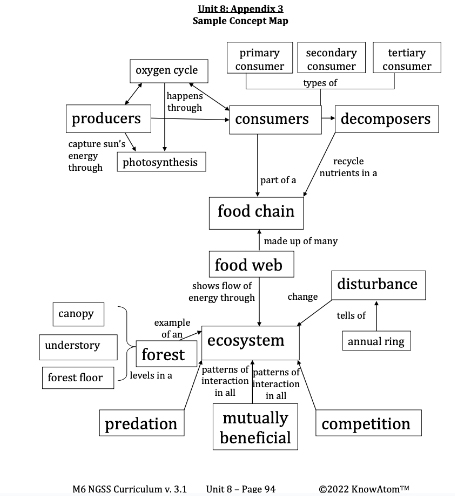The science background section gives teachers more in-depth information on the phenomena students explore.. Below is an excerpt of the science background information from this lesson on phenomena of photosynthesis.
How Plants Make Food
Different parts of the plant work together so that photosynthesis can happen. Photosynthesis happens in the chloroplasts of plant cells. Remember that plant cells are the only kind of cells with chloroplasts, which make chlorophyll, a pigment that absorbs sunlight.
Plant leaves also have pores called stomata that allow plants to take in carbon dioxide from the environment and release oxygen. The stomata open and close so that plants can constantly exchange these gasses, similar to how people always breathe in oxygen and breathe out carbon dioxide. The back-and-forth exchange of carbon dioxide and oxygen between plants, animals, and the environment is called the oxygen cycle.
The roots collect water and nutrients from the soil, and the stem transports the water and nutrients between the roots and the rest of the plant. The stem also absorbs some water, although not as much as the roots.
In scientist Suzanne Simard’s experiment, she put plastic bags over individual trees. She then injected carbon-14 into one bag covering a birch tree to see if it would transfer some of the carbon to other trees nearby and waited for an hour. She then used a Geiger counter to detect whether the carbon-14 had been transferred to the other trees.
Simard’s results showed that at that time of year, in the summer, the birch trees sent extra carbon to the fir trees. Suzanne believes this benefited the fir trees because the fir trees tended to be more shaded than the birch trees, so they received less sunlight to carry out photosynthesis. Suzanne and her team did follow-up experiments that showed at later times of the year, the fir trees sent more carbon to the birch trees. She believes this is because birch trees begin to lose their leaves in the fall, making it harder to photosynthesize, while firs keep their leaves.
Simard and other researchers have found that trees in a forest are connected through a complex underground network made up of fungi mycelium that carry carbon molecules between the trees. A forest is any area covered with trees. “They're actually sending messages back and forth that balance the resource distribution among the community,” Simard said in a 2017 interview with TED Radio Hour.
Sunlight in Forests
Simard’s research has also led her to conclude that there are “hub trees,” which she calls mother trees because they nurture their young. The mother trees have grown tall enough to reach the forest’s canopy, which is the upper layer of the forest where the treetops meet and form a thick cover. Canopy trees access most of the forest’s energy because of the amount of sunlight they receive.
The mother trees help their young, which grow in the understory. The understory of a forest exists below the canopy, which means that less sunlight reaches this layer because it has to filter through the canopy. As a result, plants in this layer must be able to make food with a limited amount of sunlight. Suzanne’s research showed that mother trees send extra carbon to the seedlings growing in the understory, which helps the seedlings survive because plants use some carbon atoms to build and repair their different structures. It also benefits the mother trees. When their offspring survive, they are more likely to reproduce and pass their genes along to future offspring.
There is even less sunlight on the forest floor than in the understory. The forest floor is blanketed with decaying leaves, twigs, fallen trees, animal scat, moss, and other organic particles.








